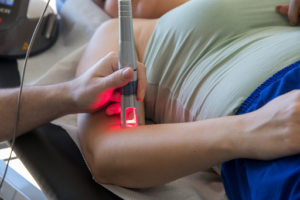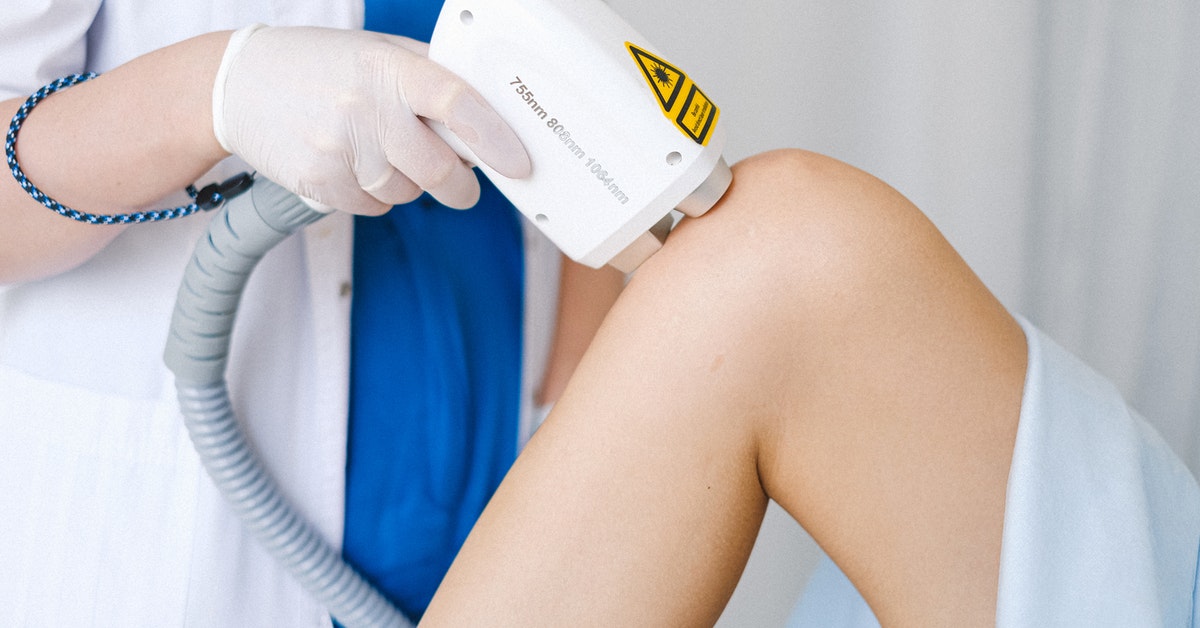Pain associated with a surgery, injury, or chronic condition can be frustrating to deal with. Medications can be addictive and only act as a band-aid solution. Everyone dealing with pain wants to heal faster, achieve lasting pain relief, and do so safely. Luckily, there are solutions that provide all these benefits. One of them is K-laser therapy. You may have heard it referred to as cold laser therapy. Here’s everything you need to know about this innovative treatment:

How Does K-Laser Therapy Work?
The body’s healing process depends on blood flow to bring in immune cells, oxygen, and nutrients. Inflammation is a normal part of healing, but sometimes excess inflammation reduces blood flow and makes it more difficult for the body to heal. Certain tissues like ligaments, tendons, spinal discs, and joints naturally receive less blood flow than others. These areas can take longer to heal and may have trouble healing completely. A stalled healing process often causes chronic pain after an injury. The body gets stuck in the inflammatory phase of healing, causing pain and stiffness.
K-laser therapy uses a cold laser, meaning a laser that doesn’t cut. It is composed of red and near-infrared light. These types of light are absorbed into your body’s cells and converted into energy. The process is similar to photosynthesis in plants. The laser stimulates cells to produce healing factors, up your body’s intake of endorphins (natural pain killers), and speed up collagen synthesis. It also helps reduce inflammation and increase blood flow to the injured area.
K-laser therapy has been clinically proven to reduce pain and healing time.

What kinds of Conditions Can it Treat?
K-laser therapy works well on both new and old injuries. It can be used to treat acute injuries like sprained ankles, overuse injuries such as tennis elbow, and chronic pain in the back, neck, or joints. Other conditions treated include:
- Plantar fasciitis
- Chronic sinus pain and pressure
- IT Band Syndrome
- Bursitis
- Knee Pain
- Rotator Cuff Injuries
- Pulled or Strained Muscles
It can also be helpful after surgeries to repair soft tissues, such as a torn ACL. K-laser therapy can prevent excess inflammation from forming at the surgical site and reduce healing time. It is also an effective treatment for contusions (bruising).

What Does K-laser Therapy Feel Like?
The best thing about K-laser therapy is that’s it’s non-invasive and comfortable. Your provider will uncover the area to be treated and use the handheld laser device on the area. Both you and your provider will wear eye protection. Sessions last anywhere from thirty seconds to ten minutes, making them easy to fit into your day. Patients describe a warming, relaxing sensation during treatment, similar to a massage. Most patients need between 4 and 6 sessions, but some may need more depending on the extent of their injury.

Is K-laser Therapy Backed by Science?
Yes! Over 2000 studies have verified the effectiveness and safety of K-laser therapy. These studies have shown a variety of benefits, including:
- A 70% reduction in acute pain
- A 60% reduction in chronic pain
- 55% greater wound healing on day eight compared to the placebo group
- Improved knee sensitivity and range of motion after every treatment for patients with knee injuries
- In 45% of chronic back pain patients, their pain was completely resolved
K-laser therapy is proven to be both safe and effective. It helps your body heal so that you can get back to normal activities without experiencing pain.

How Long Does it Take to Work?
Most patients feel some relief after the first session. Since laser therapy stimulates real healing (instead of covering up symptoms), it may take several sessions to reach your goals. You can plan on feeling better after each session and experiencing long-lasting pain relief after you’ve completed your treatment plan.

Who Should Not Have K-Laser Therapy?
Most people are candidates for K-laser therapy. It can even be used over metal implants and on open wounds or acute injuries. It is generally accepted that patients with cancer or undergoing therapies for cancer may not be candidates for laser therapy. No injuries from laser therapy have been reported in individuals with blood disorders, diabetes, or pregnant women. However, more research is needed in these areas, so people with these conditions should consult a doctor before treatment.

Will K-Laser Therapy Replace Other Treatments?
K-laser therapy may reduce your need for pain medication. It can be used with other treatments such as chiropractic adjustment and therapeutic exercises. Excess inflammation or sluggish healing can impair progress in physical therapy or in getting back to your daily activities. Including laser therapy as a part of your broader treatment plan can accelerate healing. Adding laser therapy may help you receive more benefit from chiropractic adjustment and physiotherapy.
If you have a metal implant, you may not be a candidate for other conservative therapies, like acoustic compression or ultrasound therapy. K-laser therapy is a great alternative treatment for many patients with metal implants because it offers many similar benefits. It can also be used in patients with pace makers who are not candidates for other treatments.
Many people with acute injuries experience complete healing with K-laser therapy. In these cases, they won’t need to continue other treatments and can save a considerable amount of money and time. Even those with chronic injuries whose pain persists at a lower level may find that they no longer need other treatments to manage their pain.
K-Laser Therapy in Murfreesboro
Stanlick Chiropractic has been offering comprehensive care to patients in the Murfreesboro area for over fifteen years. We’ve seen patients leave our offices pain-free for the first time in years after receiving K-laser therapy. We believe it can work for you too. Schedule a consultation today to see how this innovative treatment can help you reach your wellness goals.

